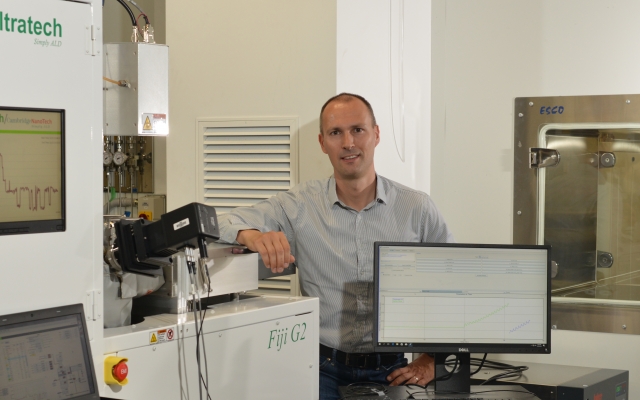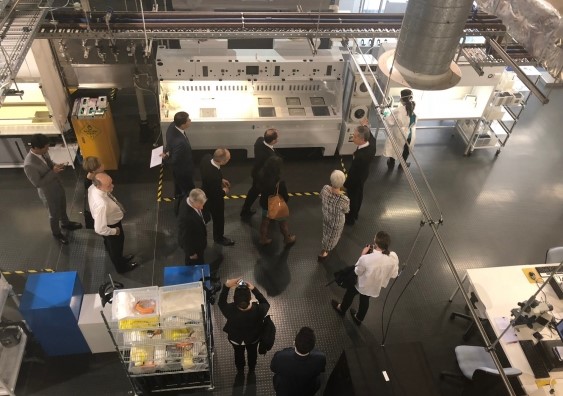
Associate Professor Bram Hoex paints a glorious picture of a research group at the very top of its game.
Associate Professor Bram Hoex says he couldn’t be a prouder spokesperson for the School of Photovoltaic and Renewable Energy Engineering (SPREE), when quizzed about their phenomenal scoop of $16 million to fund 12 new projects in the latest ARENA funding round. Being directly involved in six of them, he is also in the best position to comment.
“The Solar Industrial Research Facility brings the technology we develop to the level of industry readiness. It’s an incredible facility with prototyping machines that can make tailored products and deal with full-sized industrial samples.
Associate Professor Bram Hoex, Deputy Head of UNSW Photovoltaic and Renewable Energy Engineering
The Australian Renewable Energy Agency (ARENA) awarded the lion’s share of the available funding (a total of $29 million) to UNSW in December 2017 and Hoex believes the award will not only allow the University to retain its reputation as the one of the world’s leading solar photovoltaic (PV) experts, but embeds it more deeply in the companies driving the solar revolution.
Underpinning the majority of the research is UNSW’s Solar Industrial Research Facility (SIRF), which Hoex says is the first of its kind in Australia. “SIRF brings the technology we develop to the level of industry readiness. It’s an incredible facility with prototyping machines that can make tailored products and deal with full-sized industrial samples,” he says.
“For example, we can do modifications on a solar cell that would be hard to do cost-effectively for a company. With a production line they only make money when the line is running, and if they have to change even one process it’s very expensive to do, whereas we can do this at a nominal cost base. The Facility dramatically speeds up commercialisation and we hope to develop even more academic and industry partnerships in the future.”
Hoex says this latest funding round by ARENA was primarily focused on projects on the cusp of deployment in industry, which suits him because that’s exactly his focus area. “All but two of the projects we got funding for are squarely aimed at industrial application with the aim of making the current technology cheaper and more efficient,” he continues.
Five of the projects are focused on UNSW’s hydrogenation technology, so using hydrogen to improve or fix potential issues in solar cells. This research line was led by the late Stuart Wenham, one of UNSW’s most successful professors who sadly passed away just before Christmas. These projects are being undertaken with specific industry partners, including Jinko Solar Co, SunPower, Trina Solar and LONGi Solar, who are looking to push their specific technologies to the next level.
“These projects are all looking at next generation hydrogen-enhanced solar cell performance which is really exciting because we can very quickly show that it works on a company’s products,” explains Hoex. “For example, they’ll send us samples from their production line and with a few relatively simple processing techniques, we show them how they can improve it. That has sparked a lot of interest among our industry partners.”

Hoex says that two projects, including the one he is leading, are focused on the development of new contacts for solar cells. “Traditionally, we use metal contacts with silver on the front and aluminium at the rear but they are not very efficient so we’re exploring a whole range of new materials that we think will vastly improve efficiency,” he continues.
Other projects are a little more isolated in terms of their focus area, says Hoex. One is focused on module technology and how new combinations of metallisation and encapsulation can reduce cost at the module step, and another is working to improve photoluminescence imaging methodologies to get a clearer picture of what’s happening inside the solar cell.
“UNSW has been leading in this field for more than a decade, thanks to Professor Thorsten Trupke, his colleague Rob Bardos and their company BT Imaging,” Hoex continues. “This project will help us optimise each part of the production process independently. That way you can increase reliability and lower cost.”
The last two projects are investigating the blossoming research area of tandem solar cells i.e. sticking two solar cells on top of each other to get higher efficiencies, although Hoex says this technology is almost certainly 10 years away from wide-scale commercialisation.
With solar PV reaching a significant milestone in 2017 by becoming the cheapest way to make electricity in some places of the world, Hoex is convinced it will be the dominant form of energy generation in the near future. “Solar PV not only directly addresses the biggest problem we face in the world: climate change, but it’s a very democratic fuel. PV is an option for all countries, including local generation and mini grids in remote communities and developing countries. That’s why I’m personally so excited to be working in this field. Not only is it scientifically rewarding but I’m working to solve some of the world’s biggest problems.”
We are actively looking for industry partners. If you are interested in finding out more about UNSW’s solar PV research and facilities, please contact b.hoex@unsw.edu.au
Written by: Penny Jones
